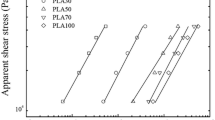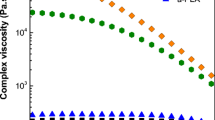Summary
Die swell behaviour and morphology of melt blends of isotactic polypropylene (PP) and high density polyethylene for pure polymers and blends with 25, 50 and 75 weight % PP are described in the present study. A light interference contrast microscopy technique was used for the morphological characterization of melt blends and extrudate samples of the blends obtained with an Instron capillary rheometer. The results indicate that the domains from blends where the dispersed phase has higher viscosity than the continuous phase remain as continuous domains in the extrudate whereas domain destruction takes place when blends where the continuous phase has the higher viscosity are extruded.
The die swell behaviour as well as the fiber forming properties of extrudates of melts having unstable domains extruded at high shear stresses resemble the behaviour of homopolymers, whereas samples with stable domains are significantly different, die swell increases with temperature at constant shear stress and stable fibers cannot be obtained after necking.
Zusammenfassung
In der vorliegenden Untersuchung werden das Strahlaufweitungsverhalten und die Morphologie von geschmolzenem isotaktischem Polypropylen (PP) und Polyäthylen hoher Dichte sowohl für die reinen Polymeren als auch für deren Mischungen mit 25, 50 und 75 Gewichts-% PP beschrieben. Die Charakterisierung der Morphologie der Schmelzenmischungen und ihrer mittels eines Instron-Kapillarrheometers hergestellten Extrudate erfolgt mit einer mikroskopischen Phasenkontrastmethode. Die Ergebnisse zeigen, daß Schmelzenbereiche, in denen die disperse Phase eine höhere Viskosität besitzt als die kontinuierliche Phase, im Extrudat als kontinuierliche Bereiche erhalten bleiben, wohingegen beim Extrudieren eine Zerstörung dieser Bereiche stattfindet, wenn die kontinuierliche Phase die höhere Viskosität besitzt.
Sowohl das Aufweitungs- als auch das Fadenbildungsverhalten der Schmelzenextrudate mit instabilen Bereichen gleicht beim Extrudieren unter hohen Schubspannungen dem Verhalten von Homopolymeren, wohingegen Proben mit stabilen Bereichen sich in signifikanter Weise unterschiedlich verhalten: Die Strahlaufweitung steigt hier bei konstanter Schubspannung mit der Temperatur an, und bei der Verstreckung lassen sich keine stabilen Fäden mehr erhalten.
Similar content being viewed by others
References
Metzner, A. B., E. L. Carley, I. K. Park, Modern Plastics37 133 (1960).
Bagley, E. B., S. H. Storey, D. C. West, J. Appl. Polym. Sci.7 1661 (1963).
Arai, T., H. Aoyama, Trans. Soc. Rheol.7 333 (1963).
Vinogradov, G. V., N. V. Prozdrovskaya, Rheol. Acta3 156 (1964).
Huseby, T. W., C. G. Grogos, Polym. Eng. Sci.5 1 (1965).
Nakajima, N., M. Shida, Trans. Soc. Rheol.10 299 (1966).
La Nieve, H., D. C. Bogue, J. Appl. Polym. Sci.12 353 (1968).
McLuckie, C., M. G. Rogers, J. Appl. Polym. Sci.13 1049 (1969).
Han, C. D., M. Charles, Trans. Soc. Rheol.14 213 (1970).
Graessley, W. W., S. D. Glassock, R. L. Crawley, Trans. Soc. Rheol.14 519 (1970).
Vlachepoulos, J., M. Horie, S. Lidorikis, Trans. Soc. Rheol.16 669 (1972).
Utracki, L. A., Z. Bakerdjian, M. R. Kamal, J. Appl. Polym. Sci.19 431 (1975).
White, J. L., J. F. Roman, J. Appl. Polym. Sci.21 869 (1977).
Huang, D. C., J. L. White, Polym. Eng. Sci.9 609 (1979).
Han, C. D., T. C. Yu, AIChE J.17 1512 (1971).
Plochocki, A. P., Trans. Soc. Rheol.20 287 (1976).
Casale, A., A. Moroni, C. Spreafico, Adv. Chem. Series142 172 (1975).
Hayashida, K., J. Takahashi, M. Matsui, Proc. 5. Int. Cong. Rheol., Kyoto4 525 (1970).
Alle, N., J. Lyngaae-Jørgensen, Rheol. Acta19 94 (1980).
Alle, N., J. Lyngaae-Jørgensen, Rheol. Acta19 104 (1980).
Alle, N., Ph. D. (lic. techn.) Thesis, The Technical University of Denmark, Lyngby (1980).
Han, C. D., Rheology in Polymer Processing, Academic Press (New York 1976).
Noel, O. F., J. F. Carley, Polym. Eng. Sci.15 117 (1975).
Deanin, R. D., M. F. Sansone, Polym. Prepr.19 211 (1978).
Starita, J. M., Trans. Soc. Rheol.16 339 (1972).
Van Oene, H., J. Colloid. Interface Sci.40 448 (1972).
Nelson, C. J., G. N. Angeropoulos, F. C. Weissert, G. G. A. Böhm, Angew. Makromol. Chem.60/61 49–86 (1977).
Cahn, J. W., J. Chem. Phys.42 93 (1965).
Cahn, J. W., Trans. Met. Soc. AIME242 166 (1968).
McMaster, L. P., Adv. Chem. Series142 43 (1975).
Author information
Authors and Affiliations
Additional information
With 10 figures and 1 table
Rights and permissions
About this article
Cite this article
Alle, N., Andersen, F.E. & Lyngaae-Jørgensen, J. Polypropylene-polyethylene blends. Rheol Acta 20, 222–230 (1981). https://doi.org/10.1007/BF01678023
Received:
Issue Date:
DOI: https://doi.org/10.1007/BF01678023




